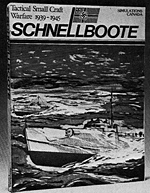
Simulations Canada
Released: 1985
Price: $20
Complexity: Beginner
Solitaire Suitability: None
** 1/2
Simulations Canada's concept of a naval war game played on the tactical rather than the strategic scale is indeed an interesting one. Most of today's naval simulations use the ideas of huge hexes and long game turns. Although these ideas allow the game to be played more quickly, they do not increase the tactical realism of the simulation. Using the Kriegsmarine concepts of 100 yard hexes and 90 second turns certainly work well in a game depicting the actions of tactical small craft during World War II.
While the components of Schnellboote are acceptable, the $20.00 price tag certainly isn't. Of course the counters are well made and the map sheet is of fairly high quality paper. The art work, however, is uninspired and one-dimensional. Add to this, that the rule book is only six pages long, the tray is of almost no use as a game tray the publishers chose to use randomizers rather than dice, and the game has no true box (the tray serves as the box and the rule book cover art as the cover); the result is a rather poor value for the potential player. For $20.00, one expects more than the components which Schnellboote provides.
While the price detracts from the appeal of the game, it must be said that Schnellboote certainly is not boring. As a matter of fact, the game can be a lot of fun to play. The designer provides the players wit~ an effective system to recreate the actions of small craft (PT's, E-boats, TP's and others) during World War II.
The rules of Schnellboote are organized into a five-step sequence of play. These five phases are the search phase, the gunfire phase, the vessel movement phase, the torpedo phase, and the sighted unit removal phase. Each turn of the game consists of all of these phases.
The search phase is based on the idea that all units have a specific search value and a specific aspect value. To conduct a search for opposing units, a player takes his search rating, subtracts the opponent's aspect value, and uses this result to indicate which column of the sighting table the search will be conducted on. If by rolling 2d6 the player produces a result of 's,' then the opposing unit has been sighted.
While the search phase may seem complicated, and indeed the rules do not do a very good job of explaining it, the idea does work. After the search phase is completed, the next step is the gunfire segment of the game.
The gunfire phase of Schnellboote is designed to simulate surface combat.
As with most war games, all combat is considered simultaneous, and the results are not applied until the end of the phase. The procedure for conducting gunfire combat will probably seem relatively complicated to most beginning wargamers and unholistic to the more experienced crowd. To determine the results of gun combat, the following procedure is used.
First, the defense factor of the unit being attacked is subtracted from the gunfire strength of the attacking unit. This result is used to indicate the appropriate column of the Gunfire Combat Table. A die roll result of 'H' indicates a hit on the target. At this point, the attacker will move to the Damage Incurred Table where the type of enemy unit will indicate the column and the result of a 2d6 die roll the damage incurred. The amount of damage will be listed as a letter between A and Z. To determine the exact nature of the damage still another table is consulted.
All movement, other than torpedo movement, occurs during the vessel movement phase. This phase also allows players to have their units produce smoke screens, which take effect during the next game turn.
A problem with the movement phase of the game is that the movement rates listed for torpedo boats do not take into consideration the weight of the fully loaded craft. Players must subtract one movement point for each torpedo being carried. it is easy for one to envision the problems t~at poor record keeping could cause during movement and, sadly, the publishers included no record sheets with the game to keep track of such notations.
After the movement segment, all torpedo actions are carried out. This includes launching, movement, and combat. Again, the lack of a record sheet forces players to be extra careful during the Torpedo phase. Had the designers thought ahead, this phase could be carried out much more easily.
The final phase of a game turn is the sighted unit removal phase. In this segment, all previously sighted units are removed from the map sheet and the game turn process begins all over again.
From a tactical standpoint, Schnellboote seems to be a good balance between strategy and luck. The problems with the rules are caused by the shortsightedness of the designers.
About the only truly original aspect of Schnellboote is the use of 100 yard hexes and 90 second turns. The game shows a good deal of authenticity, research, and thought. All in all, however, for those gamers interested in naval simulations Schnellboote is worth a look.
More War Game Reviews
-
Game Review: Sixth Fleet
Game Review: Star Trek: The Adventure Game
Game Review: The Falklands War: Naval Combat in the Missile Age
Game Review: Battle of Chickamauga
Game Review: Schnellboote: Tactical Small Craft Warfare 1939-45
Game Review: Reinforcements for Assault (US and Soviet)
Back to Table of Contents -- Game News #6
To Game News List of Issues
To MagWeb Master Magazine List
© Copyright 1985 by Dana Lombardy.
This article appears in MagWeb (Magazine Web) on the Internet World Wide Web.
Other military history articles and gaming articles are available at http://www.magweb.com